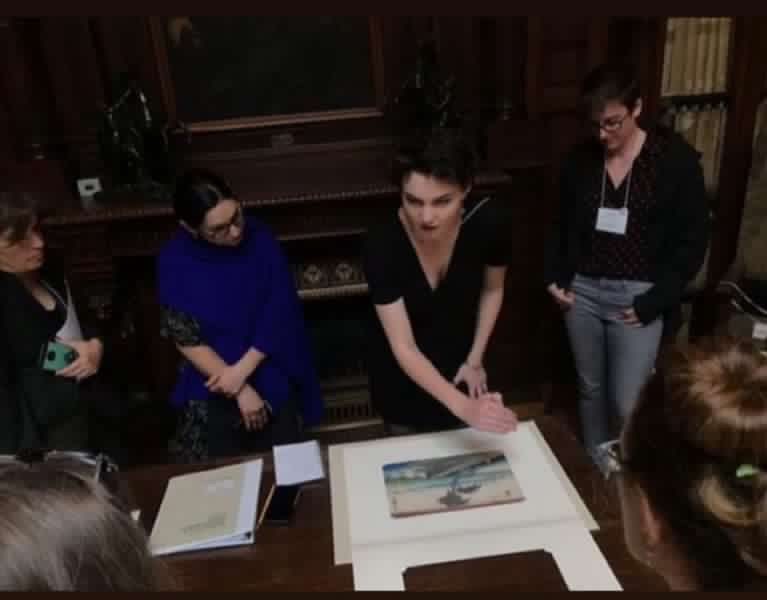
Fiona, you’re an art historian and curator specialising in Japanese art at the Worcester Art Museum in Boston. How did you get there?
I started my education at the Pratt Institute in Brooklyn, New York. I initially started at as a studio art major, but I was really interested in sort of the interplay between the technical processes and how you can actually see them manifested in historic objects. And then I got an internship at the Metropolitan Museum of Art, in the Islamic Art Department, cataloguing ceramic shards.
For a while, I was just trying out a lot of different things – I went from cataloguing on the mat to another museum as a curatorial intern and that was much more bureaucratic. I was just really interested in working with objects hands-on. My first grad experience was at an archival studies program at the University of Hawai’i at Manoa because they had such an amazing Asian rare book and rare materials collection. And they have the University of Hawai’i Press, which is quite well known for Asian art historical publications and things like that. I liked it- it was good, and I made a lot of great friends in Hawai’i, so I was really enjoying myself, but it was in the pandemic, so I left about two or three months in and decided ultimately not to do something that involved learning how to physically handle and sort objects while online- At that point, I knew I was really interested in working in Japanese materials, I knew I needed to bolster my language skills to start working in that field – work in Asian special collections – so I applied to do the Japanese Studies MA at SOAS in London. And that is what I did. And then I applied to go to Japan after that, but then the Delta variant of COVID came through and I was denied a visa.
I kind of hopped around a couple of jobs as I was finishing my master’s degree before finding my current job as a curatorial assistant. I wrote a review of an exhibition at the Worcester Art Museum – it was called “The Kimono in Print” – and the Asian curator at the time really liked my writing style and the way that I approached the exhibit. So when there an opening for a Japanese art consultant they reached out to me, knowing I was local. So that’s kind of my roundabout journey.
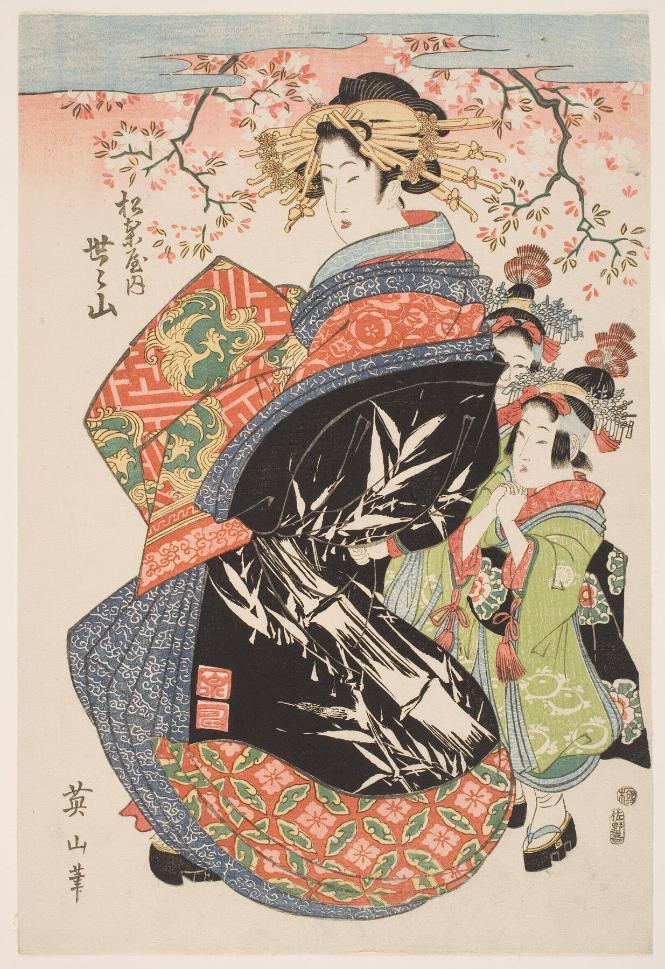
at the Worcester Art Museum
I’ve also worked as a museum docent. It was an interesting thing, going from the museum education department to more research-oriented things because I think having talked so long with people who are going to museums, you get a sense of what they’re actually looking for and what appeals to their eye. I feel my hands-on experience gave me insight into the experience of the people who you’re trying to make the art accessible for.
Why did you focus on objects to begin with, the materiality of them – what attracted you to that?
I think I’ve always had a bit more of a creative bent. I chose an art school to go to, where I think other people there really saw art as a vehicle for expression. And it was really interesting and inspiring to be around. They were entrenched in their own vision and wanted to communicate their vision of the world through these materials.
Then I took an art history class and I had a wonderful teacher. So I ended up switching majors to fine arts and art history as a freshman in college. I was 18, so I don’t think I had quite an idea where it was going to take me, but I liked the idea. Kind of indulging the hands-on tactility that had attracted me to art as well as the fitting things categorically into boxes – the pipeline from working with my hands to seeing things in a much more profound and interesting way was a very interesting one.
Part of it was just the prestige of it too – being 19 in New York City, coming from a small town, and then you kind of find yourself in the bowels of the Met, working with these objects that are two thousand years old and it just makes you feel very important. (Laughs) There’s always something new to find about them, too. And you meet the most interesting people. So I think the environment of museums attracted me just as much as the handling of objects themselves.
Yes, you know what Walter Benjamin says about the aura of the work of art, that there’s this almost religious aura to art objects. Touching them, in that environment which was really special, must have been quite something.
I’m teaching a class this semester at Clark University. And it’s funny because in my second class I was talking about the idea of the connoisseur in Japanese art and so we were talking about ukiyo-e prints, pictures of the Floating World. And they’re popular art. The prints that you would see in museums now that I work with are kind of the equivalent of posters or baseball cards, postcards or something like that. They weren’t very valuable at the time they were created – even though they can certainly be very valuable now.
But they still were objects of deep consideration for people, especially those who felt alienated from the academic circles of the upper classes. There was an increasingly literate population among the lower classes, and they were increasingly wealthy in an era of peace. Prints are interesting in that they facilitated new dialogues academically, intellectually, philosophically, religiously.
And yet my students were bored to death. I could tell they were not really getting it, and it’s really hard to understand just looking at slides. So we went to see an object in the Worcester Art Museum – it’s called Seiro Bijin Awase Sugata Kagami, which means “A Mirror of Beautiful Women of the Green Houses Compared”. It depicts the physical characteristics of courtesans and prostitutes in the red-light district, but then there’s poetry next to them. So it’s appealing to both the intellectual client who’s looking for this new space of discourse as well as the people who are looking for a sexual outlet.
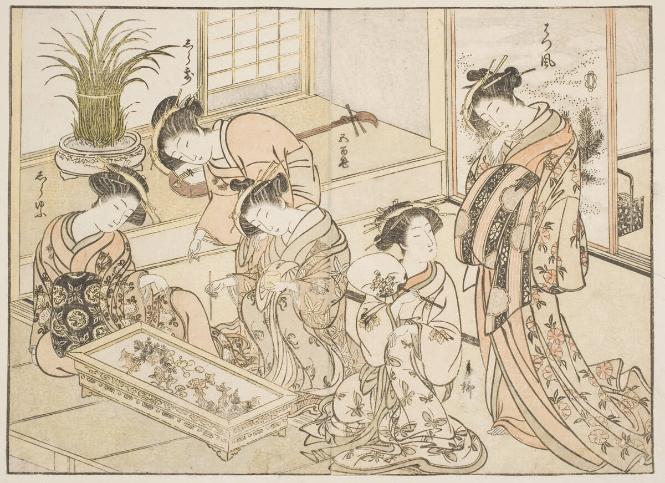
And when you go to see it in person, you can see that there are finger marks, fingerprints on the faces, on the hands. You can see where people had been pointing over time – even if you had greasy hands, this is covered in fingerprints. When you see it, it’s kind of gross and kind of chauvinistic (laughs) but when the students saw it in person, they went “that’s so cool”. That kind of physical proximity tells you much more than historians ever could know just looking at slides.
One of my favourite examples of this kind of misinterpretation is when they said that conservators in the 1980s were ruining the Sistine Chapel by cleaning it. Because people had written dissertations about how smoky and moody it was, and way before his time. So they had all these studies on that, of Michelangelo being very dark and moody. But then it turns out it was just all of the smoke and candles and stuff that had built up over time.
And if you had asked a fresco maker – and there are plenty of those in Italy – at any point they would have told you that using bright primary colours was far more likely, and far more typical of that time and style. But they didn’t! And then it came to light in the 1980s and everybody was going “They ruined it!”
I’m always saying, ask artists, look at the art up close, or else you miss so much.
It’s not moody, It’s just dirty!
It’s just dirty – it’s all the pollution and the cigarettes that people were probably smoking in the fifties and sixties and the incense and the candles and all these things. It’s like four hundred years of grime. Nobody who studied it had ever got up close and looked at it that way. I think that it’s been like a recent trend to incorporate the testimony of and opinions of artists into museum work and art history.
That’s amazing. It’s really exciting that museums are starting to think about this more seriously. Your specialisation is in 19th century Japanese art then, is it?
I mostly work with art of the Edo period, so it’s 1603 to 1868. I would definitely say that the 19th century art is the most visually appealing. Recently I’ve been working more with art in the 20th century as well, so I would say maybe 1600 to 1950ish.
And in your dissertation, which I was lucky enough to read, you focused on art that was not very elevated, art that was more popular. You talked about fans, about artists who also had a line of work painting fans.
Yes! I focused on the artist Nakamura Hōchū. What interested me about fans in particular was that they carried the motifs that he developed in his most famous designs. And there’s so much information about how they would be seen in the context of Edo fashion consumption. Whereas his printed books, which are historically his most famous contributions to the canon – it was such a limited edition, and so there’s little information about how it was received beyond how the motifs were perpetuated in other art.
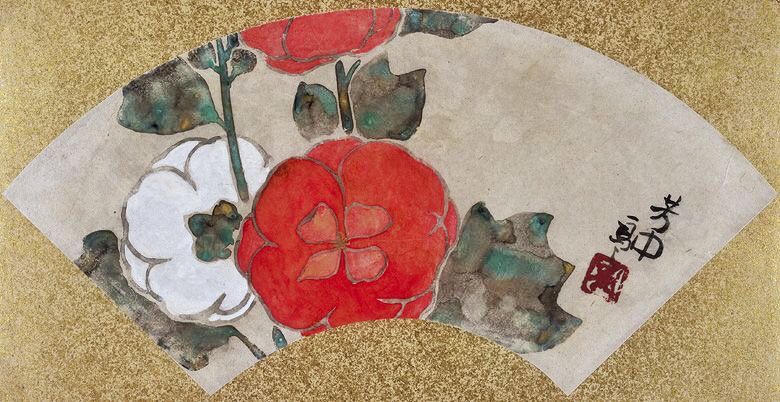
I just thought that It was an interesting opportunity to speak about his objectives and speak about his strategies as an artist, as well as elevate things that are often given their own category and incorporate that back into the conversation. I’m of a mind that costume design is probably one of the most important aspects of art history. It’s inherently intertwined with art history in a way that hasn’t really been explored very often. It’s often been explored separately, with the exception maybe of tapestries once in a while. It was an interesting way to combine two conversations into one thesis.
It worked really well – I thought it was fascinating. Could you tell me a little bit about this artist? Because, from what I gathered, he had this double strategy – he was an established artist and then he had this sideline of fan work, which, as you say, incorporated his best-known motifs. So it was a sort of personal branding avant la lettre?
Yes, the idea of copyright didn’t exist in pre-modern Japan. And when it came to printed objects in particular, the closest thing that equates to copyright is that the publisher owned the blocks. So you could make a similar block, but it was going to be pretty clearly not the original design. There was that assurance.
My argument was that there were certain physical and technical elements to Nakamura Hōchū’s fan design that suggested to me that he was trying to both protect and solidify certain designs as his own. His biggest accomplishment and historically his most well-respected work within his lifetime was an art book, Korin Gafu. After he published it, he took the motifs from that book and applied them to fan designs. Which the most visible kind of printed object or painted object that one could arguably have. Because they were seen in these circles of fashion and discourse in the floating world. He was connecting his name to the designs both in his book and in his fan work.
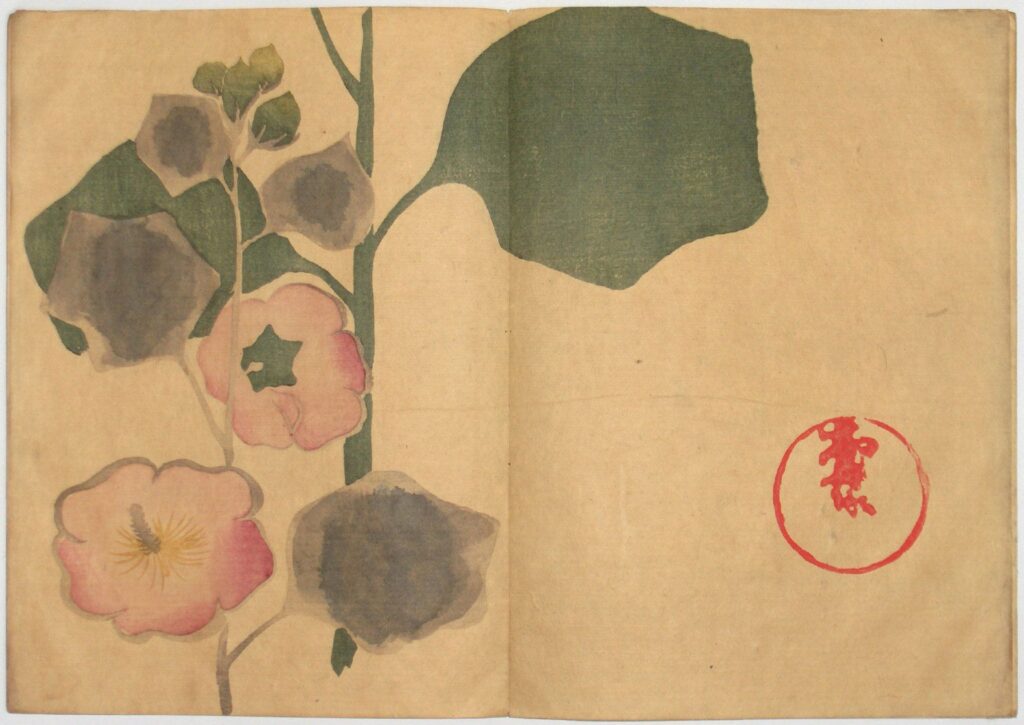

This is supported, I think, by the fact that his signatures were extremely large. His trademark tashi komi technique was also extremely pronounced – you could even see it from a distance. Fans isolated those motifs and made them bigger: they popped a little bit more, the contrast was much higher.
About 80 % of his surviving body of work is fans. And I thought that was just interesting because I had only ever read about him in relation to his book publication, which is strange because it was a limited edition and it is obviously a portable object that’s closed. And since it was a limited edition, I would think that for the most part it stayed on a shelf. So how do we know his work so well and how can we immediately identify his work as his own? And I think that’s probably because of his fan work.
And also, of course, this was the time of lots of social mobility, I understand, in Japanese society. So his work is, his fans particularly, would have been more affordable than other types of art. Would people have purchased them as status markers?
I wouldn’t say social mobility. There was a pretty rigid social stratification in pre-modern Japan that was based on the Confucian social structure that had been imported from China. So actually social structure up through the Edo period had been really stringently enforced by the ruling Tokugawa government. There were periodically sets of laws that delineated the different factions visually. For example, banning access to a specific expensive pigment to the lower classes.
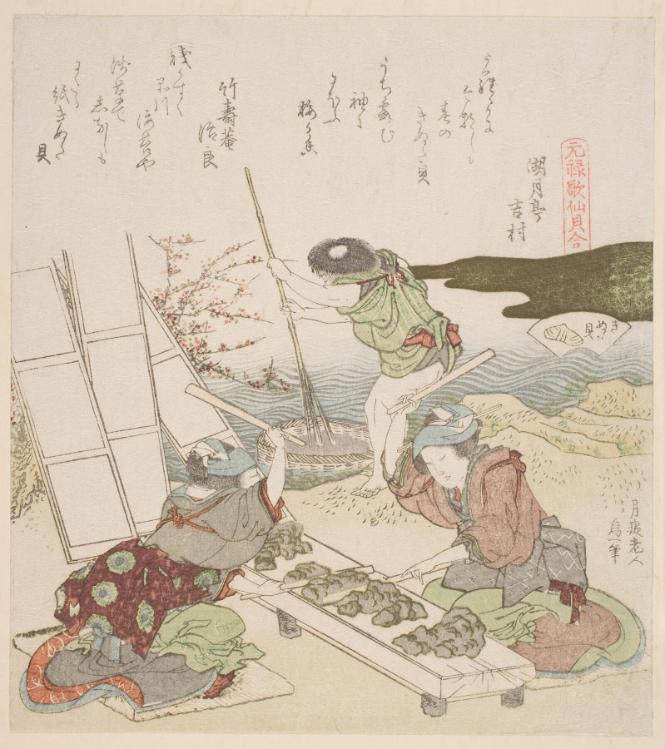
There was a mobility, though, in the sense that it was a time of peace under this government’s iron fist. The daimyos and the samurais were flocking to cities, which was actually required so that the shogun could keep an eye on them. They really had nothing to do. There were always little disputes, and some of them were firefighters, you know, there were things they could do, but in general they lived a life of leisure because they were the upper classes. They had no wars to wage, so they started patronising the lower classes, like actors, prostitutes, merchants in particular.
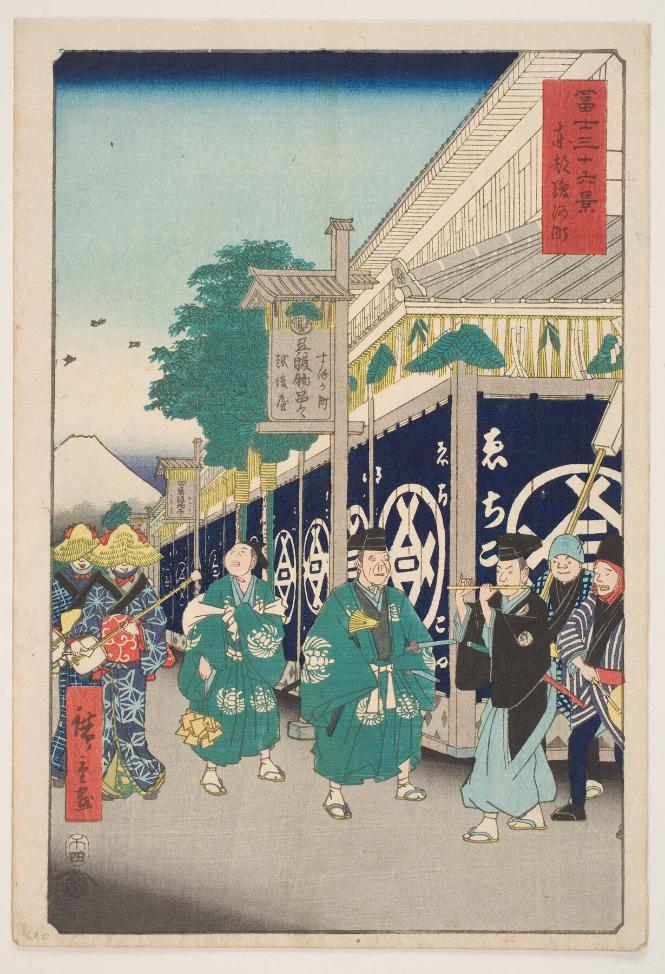
These lower classes were becoming exorbitantly wealthy. It’s a really interesting dynamic because they were interested in expressing their wealth, but the ways in which they could express it were being repressed by the government. Fan design is one of the things that is often not mentioned, but it was one way in which the lower classes showed their wealth. It also showed that they were in touch with the fashion culture and the kind of celebrity culture that emerged in the floating world, like famous artists and famous actors. The same way that you would have a t-shirt with a Gucci logo on it. A fan by a famous artist could look very chic. It was a good loophole to look elevated and wealthy without flaunting materials that were forbidden, like gold leaf, which would have attracted the attention of people in the higher tier of society and maybe even got confiscated.
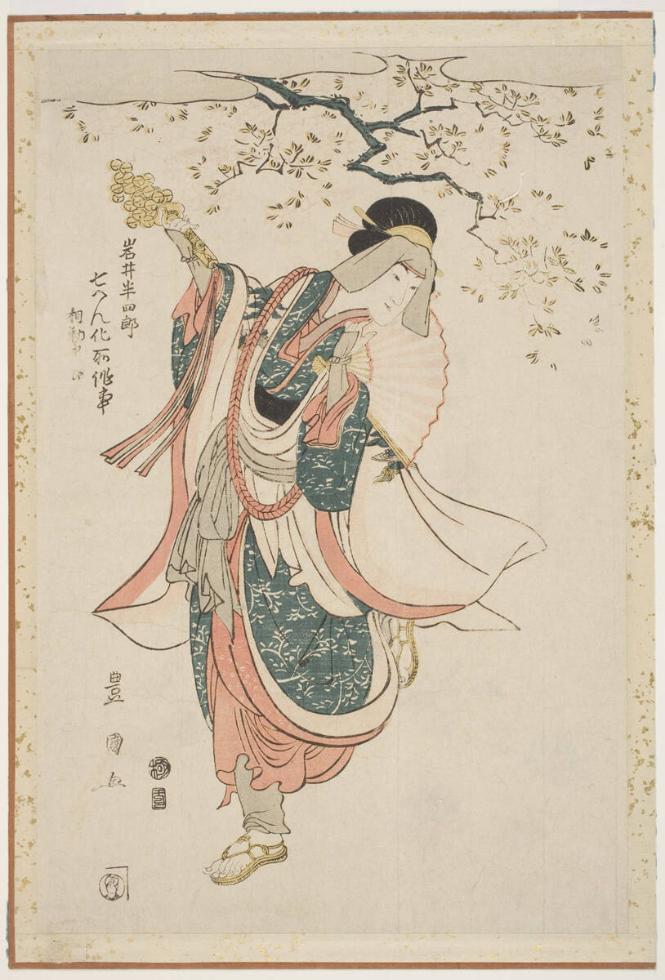
Clothes were very visible and very attractive designs that didn’t violate any laws and showed that the person was in touch with that fashion, that culture of artistic expression too.
I find that fascinating. How they found that loophole in the sumptuary laws that didn’t allow them to make use of what the aristocracy could use.
It’s a really interesting subject. The idea of the Japanese iki aesthetic is that there’s a dynamic between the simple and balanced and the lush and expressive, the psychological intensity of something. And I feel that the dynamic between the ruling class and the lower classes, the laws that the upper classes were enforcing on the lower classes to not express their wealth in a visible way, resulted in things like the lining of kimono being extremely ornate, whereas the outside is quite simple.

So when we think of Japanese design now, that’s kind of what we think about, and I think it started with that culture.
You were telling me about your interest in costumes and in clothes, and their intersection with art history, and how it’s been underserved. So are you working along these lines, as an extension of your works on fans?
Yes, definitely. Like I said, I think textile history intersects with art history in a way that’s underdiscussed. I was looking at scroll paintings the other day – the mountings are silk, because remounting paintings is very common in Asian art. If you found a textile that you thought better suited the composition, then you might add that. So by learning about what was typical of the time and what techniques had to been developed, you can get a sense of how the object changed or how it didn’t change and why.
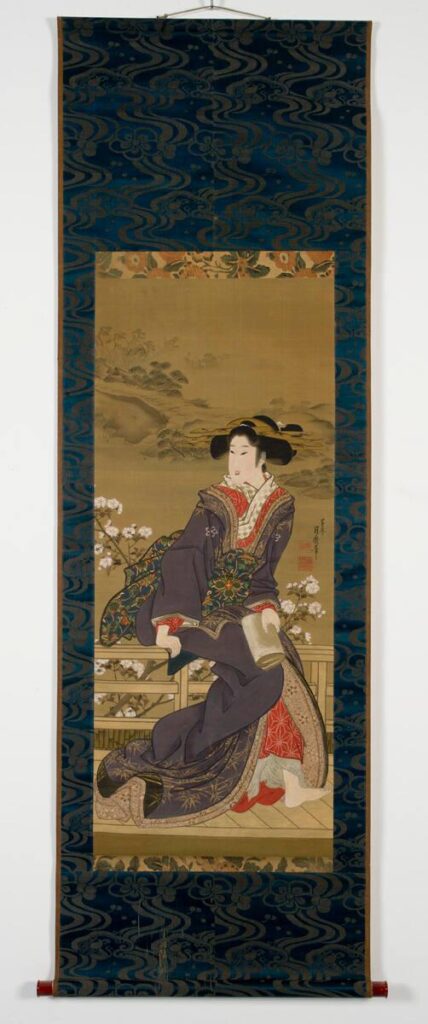
I just had an expert come into the museum the other day and she said that she thought the silk was cut out from a kimono that came three hundred years later because you can tell that the design looked more Meiji period, while the painting was from earlier. I found that so interesting – why would they do that? Maybe the kimono was somehow personal to them and they wanted to project themselves onto the painting.
It’s what you were saying – how the context feeds into the work of art, how the art piece is not an isolated thing. How they changed the mounting or the placement means a lot, and you usually miss that in museums.
And just bringing it back to fans, there’s always an extra dimension to how people interacted with the art and what it meant for them. Fashion, textiles, fans, accessories are much more intimate objects, which we use. Art is always an extension of ourselves, and when you respond to it, it’s because you’re projecting something onto it or relating to it in some way. And I think that connection is much closer between textiles and people than maybe a painting. Because if you’re looking at a painting on a wall, there’s a lot of sort of back and forth intellectually. With costumes, textiles and fans, there’s a personal element to it that is maybe lacking in other objects. I feel the same way about ceramics, because you’re drinking out of it, you’re holding it.

Things that have been traditionally allotted into the decorative arts tend to be a much more intimate portrayal of how art and people develop together, in my opinion. So, just to bring it full circle back to the idea of fans, it gives a much more intimate window into how Hōchū’s art impacted the culture.
And if you insist academically in categorising everything into neat little boxes, defined by their alleged intrinsic nature, you make mistakes and end up, as you said, with the example of the Sistine Chapel. “Oh, it’s so moody”. No, it’s just dirty. You don’t know, because you don’t know the context in which it was painted and its actual physicality.
And you don’t know why a collection has been assembled. You don’t know why a specific object has survived. And there might have been something that was more significant, but maybe it was lost in a war or maybe someone threw it away because it wasn’t considered fashionable anymore. There are so many prints that were just pasted on the wall and then taken down.
Prints were collected, and we don’t really know why so many of them survived. I’m assuming they were just put in boxes somehow, in the same way people collect baseball cards now, or postcards. But so much of what we think is important and how we’ve defined the canon is based on what is available to us. It’s interesting to see what the Japanese art historians prioritise versus Western historians. Or the British Museum versus, say, someone from my museum, because I have 3,700 prints in my collection but they have probably 35,000 or so. And London has a much more much bigger academic culture – it’s like a web. Whereas Boston and Worcester are much smaller. So you reinforce each other’s opinions unknowingly, make assumptions about what’s important based on what is there.
If there’s one artist that’s very well represented, you have more information. But if the collector didn’t really like an artist, even if he was extremely important – if he didn’t really like his aesthetic or the vibe of his prints, then you just don’t study them as much and you consider them less significant. Which is actually something I was thinking about when I curated my show.
I was going to ask you about that now.
Yes – the artist Kunisada is credited with an estimated 10,000 to 20,000 designs, if you can imagine. But there’s only a couple dozen of his prints in the entire John Chandler Bancroft collection, whereas there are hundreds of prints of Hiroshige and Hokusai (who are extremely famous and you definitely would have seen their work on a tote bag or on a calendar). If somebody was studying art history, just getting acquainted with Japanese prints and didn’t know much about the literature – and most people in the 19th century didn’t, because the study of Japanese art was such a new discipline – they would assume that Kunisada was somehow of lesser importance. When in reality he was probably among the most popular artists of the Edo period.

When thinking about collections through, the other thing to consider besides the collector’s taste is that when artists like Kunisada were popular, their work was consumed more. And because more people wanted his prints, they are often in worse condition. The museum probably has a few dozen of his works, and quite a few are worse for wear because people would pore over them and touch them.
So the nature of the prints, the nature of the collectors, the nature of the type of object it is, is going to tell you a little bit more about their place in our history and how it’s changed over time.
I’m reminded of comic books and perhaps, I don’t know, James Joyce. Perhaps in the future historians might think, because James Joyce’s books would be so much better preserved, that he was the most important author of his time. Whereas in reality most people just read comics. It’s just as you said: they are so worn and pored over and used that they would be much worse preserved. Because they were actually used and bought and move around much more.
Yep, that’s a great parallel. Thinking of my childhood bookshelf, I definitely had Pride and Prejudice on there, or the Adventures of Tom Sawyer, and those are still on my bookshelf in my apartment. But the Harry Potter books I read until they were a stack of separate pages that I had to staple, I brought them everywhere with me until eventually just fell apart. What’s most important to us often isn’t really preserved for as long, or in the same way.
To bring it back to costume, what we have left trans-geographically is ceremonial in nature. Those clothes probably didn’t see a lot of use a lot of the time, or were just never used. I’d be really curious to know what the undergarments looked like, because that would tell you more about their toiletry habits and their day-to-day life and what kind of food they ate. It probably has more information about things that we want to know than the ceremonial garments.
And also to bring it back to Hōchū’s fans, a lot of them are folded – they clearly were on spokes and were used. And then collectors who really liked his work collected them and then pasted them on screens. So you can see the folded versus the non-folded fans, and that tells you a little bit about how they are used and why.
That’s a really interesting dichotomy, the folded and the non-folded – the stuff for everyday use and the collectors’ edition, so to speak.
There’s one screen that I mentioned in my dissertation. The fans are exclusively not folded and they’re all the same shape, the same motifs, and the flowers represent the seasons. So they were clearly just made all in one go and so Hōchū’s fans were well-known enought. The collecting practices tell us that, because clearly Hōchū’s fans were well enough known in his lifetime and were highly regarded enough that somebody commissioned twelve of them and posted them on a solid gold screen that they kept in their house and is now still preserved in the museum.

So they were commissioned and never intended to never be used? They were commissioned as artworks in themselves, even though they were fans, and then mounted?
I think so. There is a history of that in Asia.
That’s amazing!
It’s cool. There’s the interesting challenge of creating a composition across the fulcrum and of the potential of that.
Yes. Again, it’s all about context, and in this case, in this case, the constraints of the form, of the shape of an actual fan.
Yes, I think so. What’s funny is that the fans that Hōchū made also were typically seen in China. The day-to-day fans that they would use look circular and then they’d be on a stick so you would see them. I get the sense that was more unusual, sort of arcane, to actively use a fan that was folded on spokes in your day-to-day.
If you have ever used a folded fan, you know they’re much harder to use than the ones on the stick. It didn’t really make sense. I think it was a bit like wearing long, awkward gloves to a party – it’d be kind of fun and it would tell you a little bit about my personality. It would also probably tell you that I was wealthy, that I probably moved in circles of weird niche artists. So I would have created a mystique around myself with one statement.
And I don’t think that’s every changed. I think it’s been the same throughout history.
I was thinking exactly that – the idea of cool, or being seen as cool, that’s eternal, that’s universal across cultures. And also being utterly fabulous and a bit of a bitch showing off, too.
(Laughs). Yes, exactly. The idea of nouveau riche versus blue blood has also always existed. The lower classes, who were quite wealthy, if not surpassing the wealth of the upper classes, created a lot of tension. They tended to be much flashier and showing access to these materials tended to be a lot more obvious. They also patronised Kabuki theatre, which is extreme. I think that with Noh versus Kabuki theatre reflects the aesthetic of upper vs lower classes. Noh is very refined, very interior, the costumes are extravagant, but they’re expressed in a very subtle way with a lot of subtle subliminal imaging. Whereas Kabuki is just insane, it’s electric – it reflected the prioritisation of expression and wealth and making yourself known.
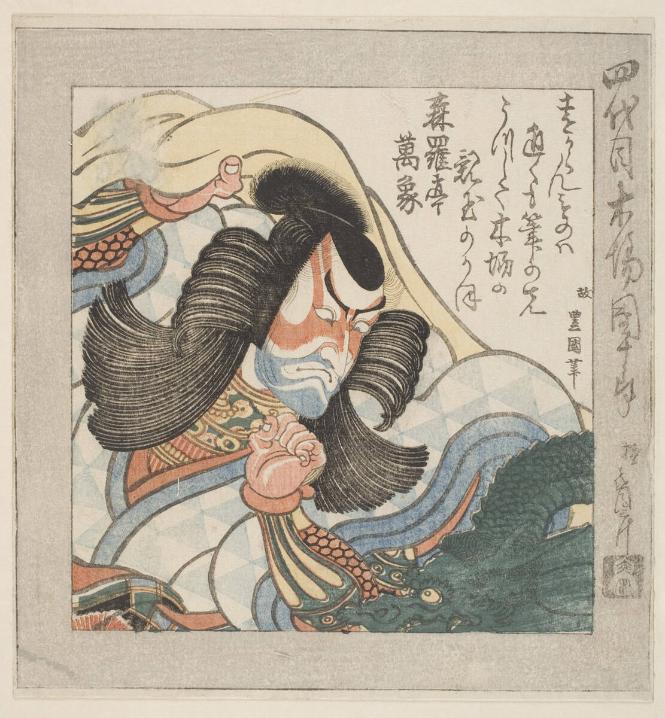
So I don’t think it’s a coincidence that Hōchū didn’t just copy his fans from his book, in which he used quite muted and gentle pastel tones. Instead, he used almost psychedelic blues and golds, just mixed them all together and they look very visually striking. I think he was in touch with that needy fashion culture and what we consider maybe a little bit more tacky – an overt expression of wealth.
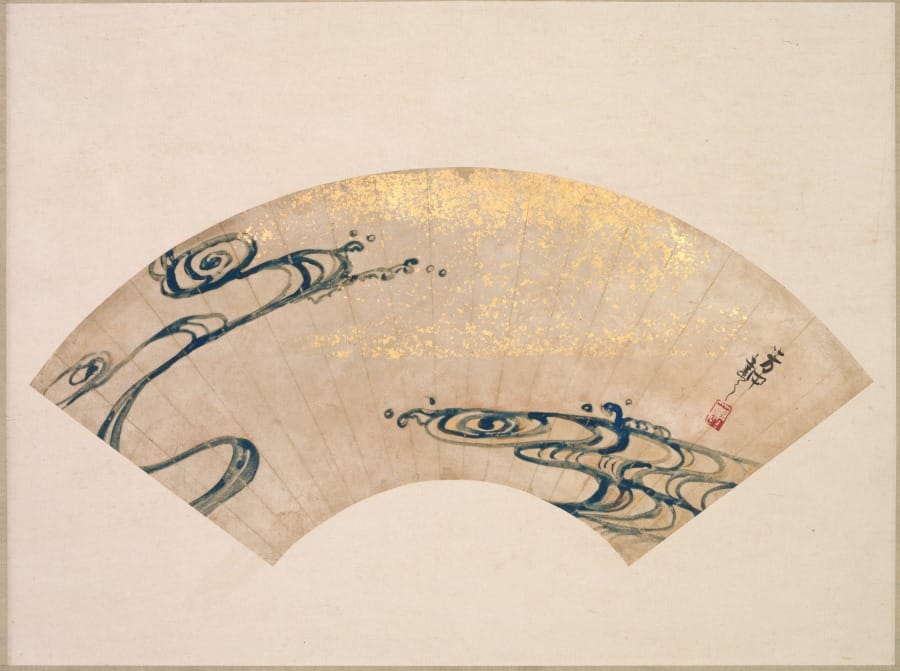
I think of the Real Housewives or the Kardashians. I love those shows! (Laughs). If you think of a Vanderbilt or an Astor, or even the Windsor family – the really wealthy and the ones who have a heritage of wealth, the way they express it tends to be much more muted. They’ll wear a pair of jeans and a t-shirt and a trench coat, and you’re just like, “Oh my gosh, I know for a fact I couldn’t afford that in a year.” They exude wealth in that way – their hair is a normal colour, it’s not done up or anything, but you can tell that haircut was five hundred dollars. I think that’s always existed too.
Yes, that’s actually where they idea of good taste comes from. From a sort of Marxist point of view, it’s really insidious, because it’s really expensive, but you’re not meant to show it. Whereas if you show off, you’re tacky and nouveau riche.
I think in Japan at least, there’s the tackiness, but then there’s also the eccentricity in that particular urban culture at the time.
The edgy people.
There were a lot of edgy people. There was a lot of also rebellion against the oppression of the government at the time too. Like I said, the idea of the interior being extremely expensive. For example, a plain kimono could be lined with textiles that are an expensive pigment, or gold leaf, or imported fabrics like chintz, which were actually forbidden at the time. They were not supposed to be imported because Japan was under strict isolationism.
Artists were quite edgy too. At one point in 1842, they banned theatre actor prints. So instead of that, landscape artists would actually support their peers and put references to historical figures in the landscapes. But then the historical figures had clear parallels to a Kabuki plot, and you could recognise their features, because at this point Kabuki actors had become very recognisable.
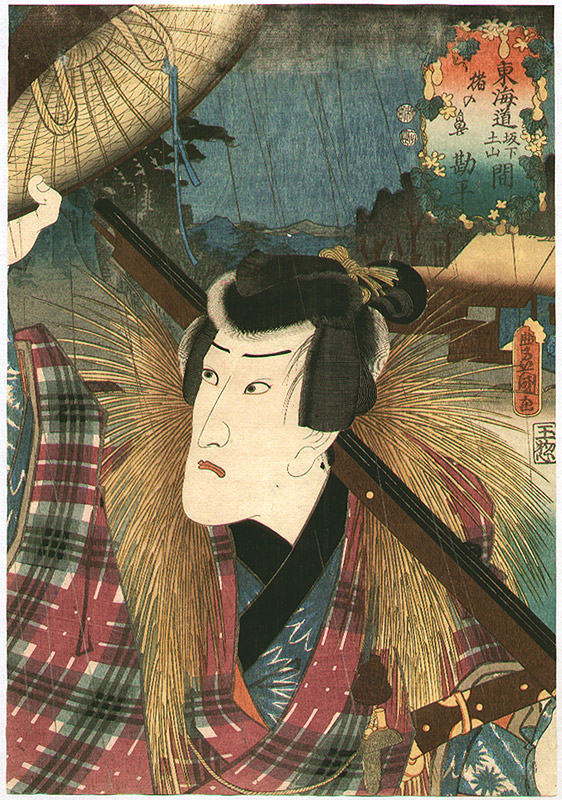
So there’s a lot of fighting the Man in this culture as well, which is always really interesting.
So cool and so fascinating. So what’s next for you now?
I’ve come to see that prints are a reflection, maybe a rose-tinted reflection, but still a reflection of the culture in which they were developed. And they catered to people who were consuming them looking to them for inspiration.
They had a resonance with popular culture in a variety of different ways. I feel like they’re impossible to understand unless you also understand the costume history, the theatre, the theatrical history, their relationship with design, with lacquer and painting. It’s impossible to know them without expanding. Most people who work with prints have kind of an adjacent interest that informs their work in a unique way.
I think it would be kind of interesting to study the interaction of costume and prints because they did have such a relationship and people were bringing books and prints into tailors saying: I like this person’s robe, could you do this pattern? And then they would recommend a vendor who had a pattern like that. And also what I said about art being mounted on textile – it’s like two sides of the same coin. That’s what I’m working on, and I think it would be an interesting direction to expand in.
Fiona Collins can be found on Instagram at @fcollins_27.